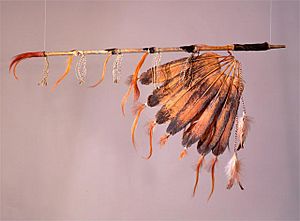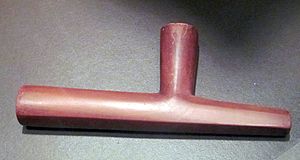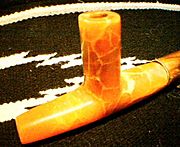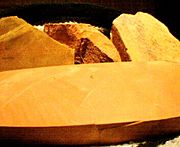Ceremonial pipe facts for kids

A ceremonial pipe is a special kind of pipe. It is used by many Indigenous peoples of the Americas in their important ceremonies. These pipes are traditionally used to offer prayers. They can also mark a serious promise or seal a treaty (an agreement between groups).
Sometimes, the pipe ceremony is part of a bigger event. Other times, it is a sacred ceremony all by itself. Indigenous peoples have different names for these pipes in their own languages. Not all cultures use ceremonial pipes. There isn't one single word for them across all Native American languages.
Contents
Pipes in Ceremonies
Europeans often called these pipes "peace pipes." The French specifically called them calumet de paix. But using a ceremonial pipe to make a peace treaty was just one use. Only some nations used them this way.
Different types of ceremonial pipes have been used. This includes pipes from Native American, First Nations, and Métis cultures. The style of the pipe, what is smoked, and the ceremonies are special. They are unique to each nation's distinct beliefs.
The pipes are also called by names in each tribe's language. Historically, ceremonial pipes were used for many things. They marked war and peace, trade, and important decisions.
In 1673, Father Jacques Marquette traveled down the Mississippi River. He saw that all Native peoples respected the ceremonial pipe. This was true even for groups who were fighting each other. He said that showing the pipe during a battle would stop the fighting. The Illinois people gave Marquette such a pipe. This gift helped him travel safely through their land.
In ceremonies, people generally believe the smoke carries prayers. These prayers go to the Creator or other powerful spirits. The Lakota tradition says that White Buffalo Calf Woman brought the Chanunpa (Lakota sacred pipe) to her people. She taught them about its meaning and ceremonies. Many Native American cultures still do these ceremonies today.
Some ceremonial pipes are decorated. They might have feathers, fur, hair, beads, or carvings. These items are important to the owner. Other pipes are very simple. Many pipes are not owned by one person. Instead, they are kept by a group, like a medicine society.
Names and Types of Pipes
Indigenous peoples of the Americas have different names for ceremonial pipes. These names are in each culture's own language. There is no single word for all ceremonial pipes. This is because there are hundreds of different Native cultures.
The Lakota sacred pipe is called a chanupa. It can also be spelled chanunpa or c'anupa.
Sometimes, old writings by colonists call a ceremonial pipe a calumet. This word comes from the Norman people. Norman-French settlers used it to describe pipes they saw Native peoples using. The word calumet means 'reed' or 'straw'.
The Calumets used in Catholic conversion rituals were often carved and decorated. The Calumet Region in Illinois and Indiana might get its name from this French term.
Materials Used for Pipes

Tobacco was first used mainly by eastern tribes. But western tribes often mixed it with other plants. This mixture was called kinnikinnick.
One material used for ceremonial pipe bowls is red pipestone. This stone is also called catlinite. It is a soft, reddish stone found in South Dakota. The pipestone quarries in Minnesota were neutral ground. People from many nations traveled there to get this sacred stone.
The Sioux people use long-stemmed pipes in some of their ceremonies. Other groups, like the Catawba in the Southeast, use round pipes. These pipes have a smoke tip pointing out in each of the four main directions.
Different Kinds of Pipestone


Many Indigenous North American cultures make and use ceremonial pipes. However, some Native American cultures do not have a ceremonial smoking tradition. They make pipes only for social smoking. The materials used depend on the community and where they live. Here are some types of pipestone and pipe materials:
- Clay: The Cherokee and Chickasaw make pipes from fired clay. These are used only for social smoking. They use small reed stems from river cane.
- Red pipestone: This stone is also called Catlinite. It is a soft, reddish stone. It is found in Minnesota (Pipestone) and Utah (Delta, Uinta). Sacred pipestone comes from Pipestone, Minnesota. Only Native Americans are allowed to quarry this pipestone today.
- Blue pipestone: This stone is mostly used by the Plains Tribes for certain ceremonial pipes. It is found in South Dakota.
- Bluestone: This is a hard, greenish-blue stone from the southern Appalachian Mountains. It has been used by several Eastern Woodlands tribes for making pipes.
- Salmon alabaster: The Uncompahgre Ute People make ceremonial pipes from salmon alabaster. This stone is mined in central Colorado.
- Green pipestone: This is a white and green marbled stone. It is found in Wyoming and South Dakota. The Shoshone, Ute, and Plains Tribes use it for pipes.
- Black pipestone (South Dakota): This is a soft, brittle, white and black marbled stone. It is found in South Dakota. Some Plains Tribes use it for certain ceremonial pipes.
- Black pipestone (Uinta): This is a very hard black stone. It is found in the Uinta Mountains in Utah and Colorado. Great Basin Tribes used this stone for pipes. When polished, these pipes are jet black and very shiny.
How Traditional Pipes Were Made

One old way to make pipes was using bow drills. These drills had hard white quartz points. Another method used wet rawhide strips. These strips were rolled in crushed white quartz. They were stretched with a bow handle to shape the pipes.
Pipe bowls could also be shaped with hard sandstones. Then, they were polished with water and fine sand. Finally, they were rubbed with fat or oils to make them smooth and shiny.
Images for kids
See also
 In Spanish: Calumet para niños
In Spanish: Calumet para niños


